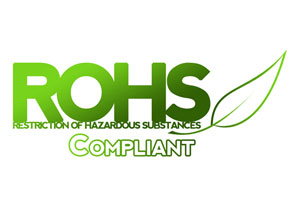The expression RoHS is the initials of the term Restriction of Hazardous Substances Directive, which is used to limit the use of certain harmful substances in English. The 2002-95-EC directive was adopted by the Council of Europe in January 2003 and is a directive requiring the use of certain harmful substances in electronic cards or electronic products. It is forbidden to use the following substances which are harmful to human health: Lead (Pb), Mercury (Hg), Cadmium (Cd), Plus 6 valence Chromium (Cr6 +), Polybromide biphenyl (PBB) and Polybrominated biphenyl ether (PBDE).
There are two reasons why heavy metals and components such as lead, mercury, cadmium and chromium are included in the scope of RoHS. The first reason is that these elements are elements that threaten human health. The second reason is that if these elements cannot be recycled and they are left uncontrolled to the environment, the damage to the environment and the dangers posed by the living beings continue.
Electrical and electronic devices and electronic cards, where these elements are mostly used, remain under high heat pressure and with this warming effect, they cause more toxic particulate mixing into their environment. Products for this type of human contact RoHS directive are covered.
With the RoHS directive, the restriction of the use of certain harmful substances has entered the UK national law in 2013. In short, RoHS has been used to limit the use of hazardous substances.
Based on the use of hazardous elements for human health, soldering is often used in electrical and electronic tools. There is no escape from it. However, in order to comply with the aforementioned directive, tin mixture with tin or silver and tin mixture with copper will be preferred. Mercury is an additive used in all batteries. However, no more mercury-free batteries will be produced. Some elements are often used in contact cleaners. For example, contact cleaners are used to provide permanent conductivity in electrical connections, or in the cleaning of cables and connections on cars and motorcycles or in the cleaning of television, radio and small hand tools. The so-called contact cleaner sprays create a range of hazards that can cause pregnant women to drop children or cause the cells to die.
RoHS directive, in our country EEE Regulation 2008 was published in the Official Gazette in May and entered into force. The full name of this regulation is the Regulation on the Restriction of the Use of Certain Hazardous Substances in Electrical and Electronic Equipment.
The purpose of this regulation is to protect the environment and human health. For this purpose, the use of certain harmful substances in electrical and electronic equipment is restricted. The Regulation also lists the practices that will not be subject to these restrictions in the annexed list. In addition, the regulation includes administrative, legal and technical regulations for the control of imported electrical and electronic goods. Similarly, the principles for recycling and disposal of electrical and electronic goods without harming the environment are also regulated by the regulation.
In addition to the regulation, there is a detailed list of the categories of electrical and electronic goods and these categories. The regulation covers all electrical and electronic equipment, electric lamps, lighting equipment used in homes, toys, entertainment and sports equipment, automatic vending machines, information technology and telecommunication equipment.
According to the EEE Regulation, the use of elements other than the above mentioned cadmium must be less than one thousandth in electrical and electronic devices produced by the manufacturer companies. In cadmium this rate is one in ten thousand. Companies can not make a production that exceeds these rates. Very special analysis devices are used in the analysis of these ratios.
Producer companies are also obliged to keep the information and documents that the products offered to the customers meet the required criteria according to the directive for five years. Again, manufacturer companies must prepare a declaration of conformity for their products once a year by the end of February and submit them to the Ministry of Environment and Forestry.
Producer companies, in the electrical and electronic products they produce, have to perform analyzes to prove whether the above described use is restricted or prohibited. RoHS Certificateis a document given by the results of these analyzes.
The prohibited substances, the maximum values accepted and the usage areas of these elements are as follows:
|
elements |
Maximum value |
Usage areas |
|
Lead (Pb) |
Percent 0,1 |
Solder, active and passive electronic material, termination tips, printed circuit coatings, glass, batteries and batteries |
|
Mercury (Hg) |
Percent 0,1 |
Batteries, switches, sensors, relays, fluorescent bulbs |
|
Cadmium (Cd) |
Percent 0,01 |
Electrolysis coatings, plastic materials, sensors, NiCd batteries, sparking contacts |
|
Plus Chrome with 6 (Cr6 +) |
Percent 0,1 |
Chrome coatings |
|
Polybrominated biphenyl (PBB) |
Percent 0,1 |
Anti-flammable materials |
|
Polybrominated biphenyl ether (PBDE) |
Percent 0,1 |
Anti-flammable materials |
our company TÜRCERT Technical Control and Certification As well as all quality systems, the company provides a strong staff and technical infrastructure to the demanding manufacturers. In order to receive or request RoHS Certificate, you can contact our executives immediately.



